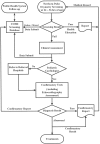Development of a Newborn Screening Program for Critical Congenital Heart Disease (CCHD) in Taipei
- PMID: 27073996
- PMCID: PMC4830600
- DOI: 10.1371/journal.pone.0153407
Development of a Newborn Screening Program for Critical Congenital Heart Disease (CCHD) in Taipei
Abstract
Background: Early detection of critical congenital heart disease (CCHD) can significantly reduce morbidity and mortality among newborns. We investigate the feasibility of implementing a community-based newborn CCHD screening program in Taipei.
Methods: Twelve birthing facilities in Taipei participated in a trial screening program between October 1, 2013, and March 31, 2014. Newborns underwent pulse oximetry at 24-36 h old, with probes attached to the right hand and one lower limb. Any screening saturation ≥95% in either extremity, with an absolute difference of ≤3% between the right hand and foot, was accepted as a screening pass. A screening result was considered as a fail if the oxygen saturation was <95% at either probe site, on 3 separate occasions, each separated by 30 min or the first result was <95% at either probe site, and any subsequent oxygen saturation measurement was <90%. Public health nurses would follow up all missed or refused cases.
Results: Of the 6,387 live births, 6,296 newborns (coverage rate: 6,296/6,387 = 98.6%) underwent appropriate pulse oximetry screening. Sixteen newborns (0.25%) were reported to have a failed screening result. Five of these screen positive newborns were confirmed with CCHD; two of them were diagnosed solely attributed to the failed screening results. The false-positive rate was 0.18%. Implementing a 6-month screening program for CCHD produced good case detection rate, while using efficient screening and referral systems.
Conclusion: This program was successful in integrating screening, referral and public health tracking systems. The protocol outlined in this report could provide a community-based model for worldwide implementation.
Conflict of interest statement
Figures


Similar articles
-
Early screening for critical congenital heart defects in asymptomatic newborns in Bursa province.J Matern Fetal Neonatal Med. 2016;29(7):1105-7. doi: 10.3109/14767058.2015.1035642. Epub 2015 Apr 22. J Matern Fetal Neonatal Med. 2016. PMID: 25902399
-
Early screening for critical congenital heart defects in asymptomatic newborns in Mazovia province: experience of the POLKARD pulse oximetry programme 2006-2008 in Poland.Kardiol Pol. 2012;70(4):370-6. Kardiol Pol. 2012. PMID: 22528711
-
Neonatal pulse oximetry screening improves detecting of critical congenital heart disease.Chin Med J (Engl). 2013 Jul;126(14):2736-40. Chin Med J (Engl). 2013. PMID: 23876906 Review.
-
Comparing Strategies for Critical Congenital Heart Disease Newborn Screening.Pediatrics. 2023 Mar 1;151(3):e2022057862. doi: 10.1542/peds.2022-057862. Pediatrics. 2023. PMID: 36815269
-
Screening for Critical Congenital Heart Disease.Clin Perinatol. 2016 Mar;43(1):73-80. doi: 10.1016/j.clp.2015.11.005. Clin Perinatol. 2016. PMID: 26876122 Review.
Cited by
-
Cardioplegia in Open Heart Surgery: Age Matters.J Clin Med. 2023 Feb 20;12(4):1698. doi: 10.3390/jcm12041698. J Clin Med. 2023. PMID: 36836232 Free PMC article. Review.
-
Cardiac emergencies in neonates and young infants.Avicenna J Med. 2017 Jan-Mar;7(1):1-6. doi: 10.4103/2231-0770.197506. Avicenna J Med. 2017. PMID: 28182035 Free PMC article. Review.
-
Effectiveness of the critical congenital heart disease screening program for early diagnosis of cardiac abnormalities in newborn infants.Saudi Med J. 2017 Oct;38(10):1019-1024. doi: 10.15537/smj.2017.10.20295. Saudi Med J. 2017. PMID: 28917066 Free PMC article.
-
Pulse oximetry screening for critical congenital heart defects.Cochrane Database Syst Rev. 2018 Mar 1;3(3):CD011912. doi: 10.1002/14651858.CD011912.pub2. Cochrane Database Syst Rev. 2018. PMID: 29494750 Free PMC article.
-
Role of pulse oximetry in detecting critical congenital heart disease among newborns delivered at a high altitude setting in Ethiopia.Pediatric Health Med Ther. 2019 Aug 15;10:83-88. doi: 10.2147/PHMT.S217987. eCollection 2019. Pediatric Health Med Ther. 2019. PMID: 31616201 Free PMC article.
References
-
- Botto LD, Correa A, Erickson JD. Racial and temporal variations in the prevalence of heart defects. Pediatrics. 2001;107(3):E32 . - PubMed
Publication types
MeSH terms
LinkOut - more resources
Full Text Sources
Other Literature Sources
Medical

